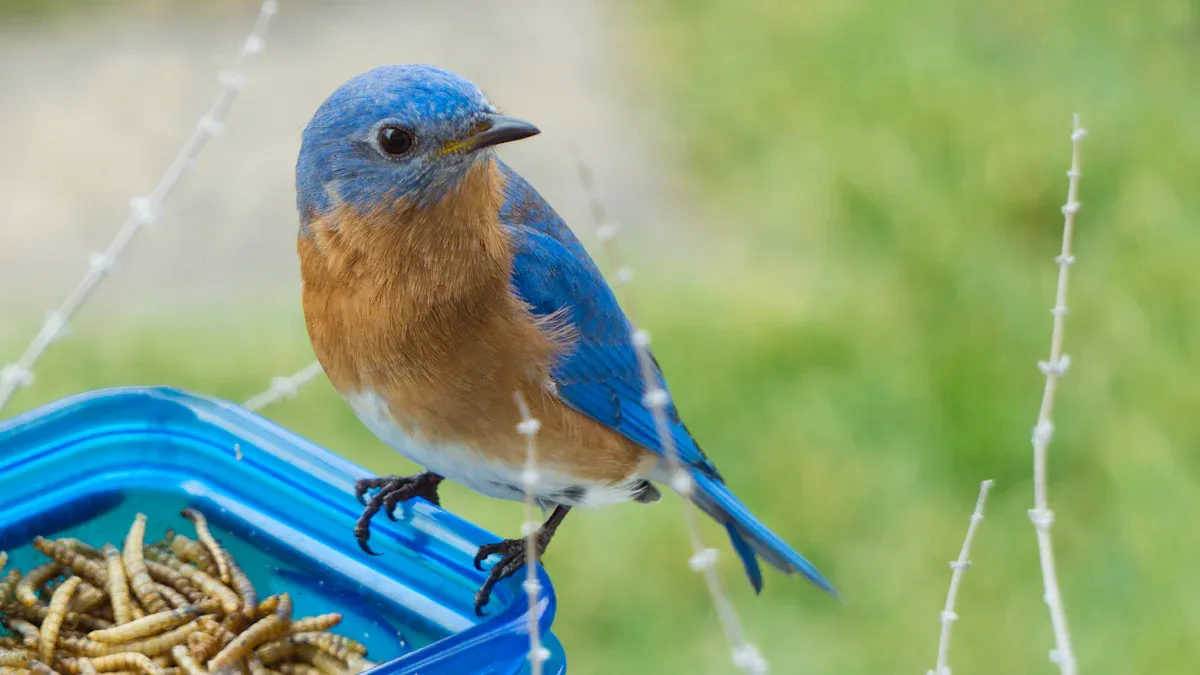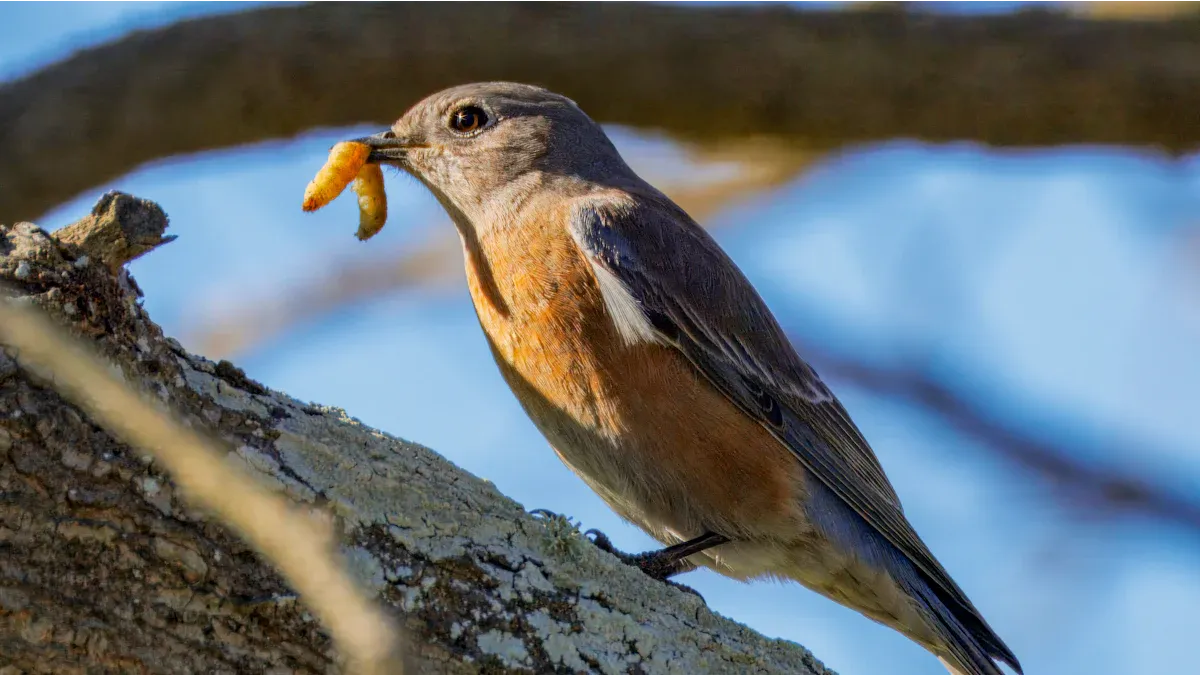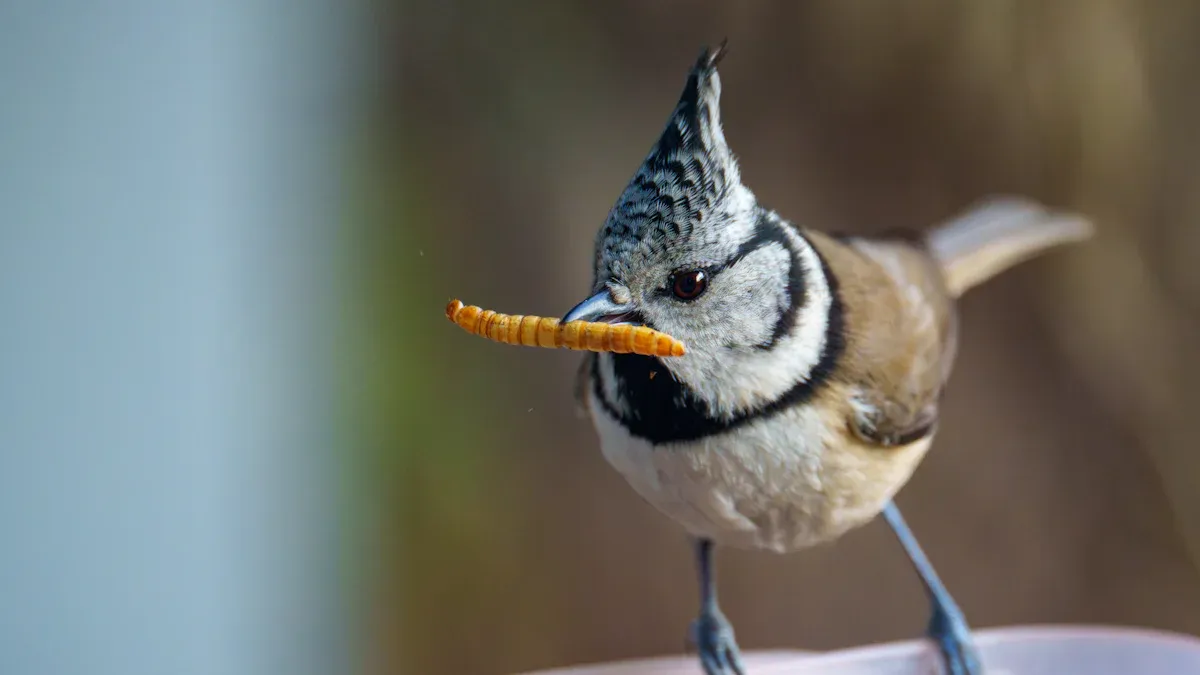
Mealworms are a game-changer for bird enthusiasts. Packed with protein and fat, they provide birds with energy and essential nutrients. Studies show that mealworms promote better growth and gut health in young birds. Adding mealworms for bird seed and feed can even attract insect-eating species, making your backyard a birdwatching haven.
Key Takeaways
- Mealworms are healthy for birds, giving them protein and fat.
- These nutrients help birds stay strong, grow, and stay healthy.
- Feeding mealworms can bring many bird types to your yard.
- This makes birdwatching at home more fun and exciting.
- Change how you feed birds during breeding, molting, or migration.
- Birds need different food at different times of the year.
Why Use Mealworms for Bird Seed and Feed?
Nutritional Benefits of Mealworms
Mealworms are a powerhouse of nutrition for birds. Their high protein and fat content make them an excellent energy source, especially for birds that need extra fuel during demanding periods. Here’s a quick look at their nutritional profile:
| Nutrient | Content |
|---|---|
| Crude Protein (min) | 52.8% |
| Crude Fat (min) | 24.7% |
This impressive nutrient composition supports muscle development, feather growth, and overall vitality. Birds like chickadees, cardinals, and woodpeckers thrive on this protein-rich diet. Adding mealworms for bird seed and feed can also attract species that typically prefer insects, enriching the diversity of your backyard visitors.
Tip: Dried mealworms are a convenient option since they don’t spoil, making them easy to store and serve.
Seasonal Importance: Breeding, Molting, and Migration
Birds face unique challenges during different seasons, and mealworms can play a vital role in meeting their nutritional needs.
- Breeding Season: During spring and early summer, birds require extra energy to build nests and raise their young. Mealworms provide the protein needed for egg production and the growth of nestlings.
- Molting Period: Birds shed and regrow feathers in late summer or early fall. This process demands a lot of energy and nutrients. Studies show that many birds are molting earlier due to climate changes, with some species shifting their molt timing by about one day earlier per year. Mealworms help meet the increased nutritional demands during this time.
- Migration: Long-distance migratory birds need to store fat reserves for their journeys. As temperatures drop, birds like European starlings increase their consumption of mealworms, which offer a concentrated source of energy.
| Habitat Type | Effect of Drought on Breeding Densities | Notes |
|---|---|---|
| Higher Elevation Habitats | Positive | Benefited from earlier snowmelt and breeding phenology. |
| Middle Elevation Habitats | Unaffected | No significant change in breeding densities. |
| Low Elevation Habitats | Negative | Reduced nest survival due to drought conditions. |
By offering mealworms for bird seed and feed, you can support birds through these critical periods. Whether they’re breeding, molting, or preparing for migration, mealworms provide the essential nutrients they need to thrive.
What Birds Eat Mealworms?

Common Bird Species That Enjoy Mealworms
Mealworms are a favorite snack for many backyard birds. Species like chickadees, cardinals, nuthatches, and woodpeckers often flock to feeders offering mealworms. Bluebirds and American robins, though less frequent visitors, also enjoy this protein-packed treat. These birds rely on mealworms for energy during critical times like breeding and migration.
Adding mealworms for bird seed and feed can attract birds that typically prefer insects over seeds. This makes mealworms a great choice for diversifying the species visiting your yard. Garden birds, in particular, benefit from the high nutritional value of mealworms, which support their growth and vitality.
Tip: To encourage a variety of birds, place mealworms in feeders near shrubs or trees. These spots provide cover and make birds feel safe while feeding.
Attracting Insect-Eating Birds to Your Feeders
Mealworms are a magnet for insect-eating birds. Studies show that feeders with mealworms can significantly increase bird activity. For example, Martinson and Flaspohler (2003) observed fewer mealworms in plots with feeders, indicating higher predation by birds. Similarly, Sanz (2001) found fewer caterpillars in areas with nest boxes, suggesting birds actively hunt nearby insects.
| Study | Findings |
|---|---|
| Martinson and Flaspohler (2003) | Mealworms in plots with feeders were reduced, showing increased bird predation. |
| Sanz (2001) | Fewer caterpillars in plots with nest boxes, indicating birds affect arthropod populations. |
| Orros and Fellowes (2012) | Aphid colonies near feeders were smaller due to higher bird predation. |
To attract insect-eating birds, offer mealworms in open feeders or trays. Birds like bluebirds and starlings prefer easy access to their food. Hooks, Pandey, and Johnson (2003) found that bird predation reduced caterpillar damage on plants, highlighting their role in controlling pests. By adding mealworms for bird seed and feed, you not only support birds but also help maintain a balanced ecosystem in your garden.
How to Feed Mealworms to Birds

Live vs. Dried Mealworms: Which is Better?
Bird enthusiasts often wonder whether live or dried mealworms are better for feeding birds. Both options have their advantages, and the choice depends on your goals and the birds you want to attract.
| Aspect | Live Mealworms | Dried Mealworms |
|---|---|---|
| Bird Performance | Positive effects on growth and welfare | Limited impact on performance |
| Meat Quality | No compromise on quality | Varies based on processing |
| Behavioral Enrichment | Stimulates natural behaviors | Less engaging for birds |
Live mealworms are excellent for encouraging natural foraging behaviors. Birds enjoy the movement, which mimics their experience in the wild. These mealworms are especially beneficial during breeding and migration seasons when birds need extra energy. However, they require more care and storage.
Dried mealworms, on the other hand, are convenient and easy to store. They don’t spoil and can be offered year-round. While they may not provide the same level of behavioral enrichment, they still deliver essential nutrients. For many bird lovers, dried mealworms are a practical choice for adding to bird seed and feed.
Tip: Consider offering live mealworms occasionally as a treat while using dried mealworms for regular feeding. This combination can keep your feathered visitors happy and healthy.
Introducing Mealworms to Birds
If birds in your yard aren’t used to mealworms, introducing them can take a little patience. Start by mixing a small amount of mealworms with their usual seed or feed. This helps birds associate the new food with something familiar.
Place the mealworms in a visible spot, such as an open tray or platform feeder. Birds are more likely to try new foods when they feel safe. Once they recognize mealworms as a food source, they’ll return for more.
Note: Be consistent with your feeding schedule. Birds quickly learn when and where to find food, so regular feeding times can encourage them to visit your yard more often.
Choosing Feeders for Mealworms
Selecting the right feeder is crucial for serving mealworms effectively. Here are some tips for choosing the best feeders:
- Use feeders with tall sides to prevent mealworms from spilling out.
- Opt for feeders with roofs to protect the mealworms from rain.
- Look for designs with drainage holes to keep the mealworms dry.
- Choose tamper-resistant feeders to deter squirrels and other pests.
For live mealworms, a shallow plastic container works well. Add 2-3 inches of bedding, such as wheat bran, and include vegetables like cabbage or potatoes for moisture. Replace the bedding and vegetables regularly to maintain cleanliness.
Tip: Place feeders near shrubs or trees to provide birds with a sense of security while they eat.
Seasonal Feeding Tips for Mealworms
Mealworms can be a valuable food source throughout the year, but their importance varies by season.
- Spring: Increase the frequency of live mealworms during nesting season. They provide the protein needed for egg production and feeding young birds.
- Summer: Offer mealworms in shaded areas to prevent them from overheating. Dried mealworms are especially useful during this time.
- Fall: Birds preparing for migration benefit from the high energy content of mealworms. Serve them in small amounts to help birds build fat reserves.
- Winter: While mealworms are less critical during colder months, they can still be a helpful supplement for insect-eating birds.
By adjusting your feeding habits to match the seasons, you can support birds through their most challenging times. Adding mealworms for bird seed and feed ensures they get the nutrients they need year-round.
Storing Mealworms
Storing Live Mealworms: Best Practices
Proper storage of live mealworms ensures they stay healthy and ready for feeding. A shallow plastic container, ideally with a capacity of 2 to 5 gallons, works well for housing them. Cover the container with a screen or a perforated lid to allow air circulation while keeping the mealworms secure. Inside the container, add loose bran or oatmeal as bedding and food. Including a few slices of apple provides moisture, which helps keep the mealworms hydrated.
To slow their growth and extend their lifespan, store the container in the refrigerator. The cooler temperature reduces their activity, making them easier to manage. However, avoid freezing them, as this can harm the mealworms.
Tip: Check the container weekly to replace old bedding and remove any spoiled food. This keeps the environment clean and prevents unpleasant odors.
For those looking to preserve live mealworms for longer periods, drying or acidifying them can be effective. Studies show that lactic fermentation of mealworm mixtures not only extends shelf life but also enhances food safety by controlling harmful bacteria.
Keeping Dried Mealworms Fresh
Dried mealworms are much easier to store than live ones. To maintain their freshness, keep them in an airtight container. This prevents exposure to moisture, which can cause spoilage. Store the container in a cool, dry place, away from direct sunlight.
If you buy mealworms in bulk, consider dividing them into smaller portions. This way, you only open what you need, keeping the rest sealed and fresh.
Note: Proper storage ensures dried mealworms retain their nutritional value, making them a reliable food source for birds year-round.
Where to Source Mealworms
Reliable Sources for Mealworms
Finding high-quality mealworms is essential for keeping your feathered visitors happy and healthy. Many reliable sources cater to bird enthusiasts, offering both live and dried mealworms. Here are some popular options:
- Pet Stores: Many pet stores stock mealworms in their bird or reptile sections. These stores often carry live mealworms, making them a convenient choice for those who prefer fresh options.
- Garden Centers: Some garden centers sell dried mealworms alongside bird seed and feeders. These are great for picking up supplies while shopping for your garden.
- Specialty Bird Shops: Stores dedicated to bird care often provide premium-quality mealworms. They may also offer advice on feeding and storage.
Tip: Always check the packaging for freshness and quality. Look for mealworms that are free from mold or unpleasant odors.
Online vs. Local Suppliers
When it comes to sourcing mealworms, both online and local suppliers have their advantages.
| Aspect | Online Suppliers | Local Suppliers |
|---|---|---|
| Convenience | Easy to order from home | Immediate availability |
| Variety | Wide range of options and bulk deals | Limited selection |
| Cost | Often cheaper, especially for bulk purchases | Slightly higher prices |
| Freshness | May take time to ship | Usually fresher, especially live mealworms |
Online suppliers like Amazon, Chewy, and specialty bird food websites offer a vast selection of mealworms. They often provide bulk discounts, making them a cost-effective choice for regular feeders. Local suppliers, on the other hand, allow you to inspect the product before buying. This ensures you get fresh, high-quality mealworms every time.
Note: If you’re new to feeding mealworms, start small. Purchase a small quantity to see how the birds in your yard respond before committing to larger orders.
Mealworms are a game-changer for bird feeding. They provide essential protein and energy, especially during migration. Offering live or dried mealworms caters to different bird preferences, ensuring their nutritional needs are met.
- Key Benefits:
- High-protein food for energy.
- Supports breeding success in urban birds.
- Attracts diverse bird species to feeders.
| Statistic/Outcome | Description |
|---|---|
| Nestling Size Improvement | Supplementation with mealworms mitigated differences in nestling size between urban and forest broods. |
| Pre-fledging Body Mass Increase | Urban nestlings benefited from an increase of approximately 2 g in pre-fledging body mass, enhancing recruitment rates. |
By learning how to feed, store, and source mealworms, bird enthusiasts can create thriving habitats. Try adding mealworms to your feeders and watch your local bird population flourish.
Article author: Felix
FAQ
How many mealworms should I feed birds daily?
Offer about 10-15 mealworms per bird daily. Adjust the quantity based on the number of visitors and their feeding habits.
Can mealworms attract pests to my yard?
No, dried mealworms don’t attract pests. For live mealworms, use tamper-resistant feeders to keep unwanted critters like squirrels or rodents away.
Are mealworms safe for baby birds?
Yes, mealworms are safe and nutritious for baby birds. They provide essential protein for growth, especially during the breeding season.


